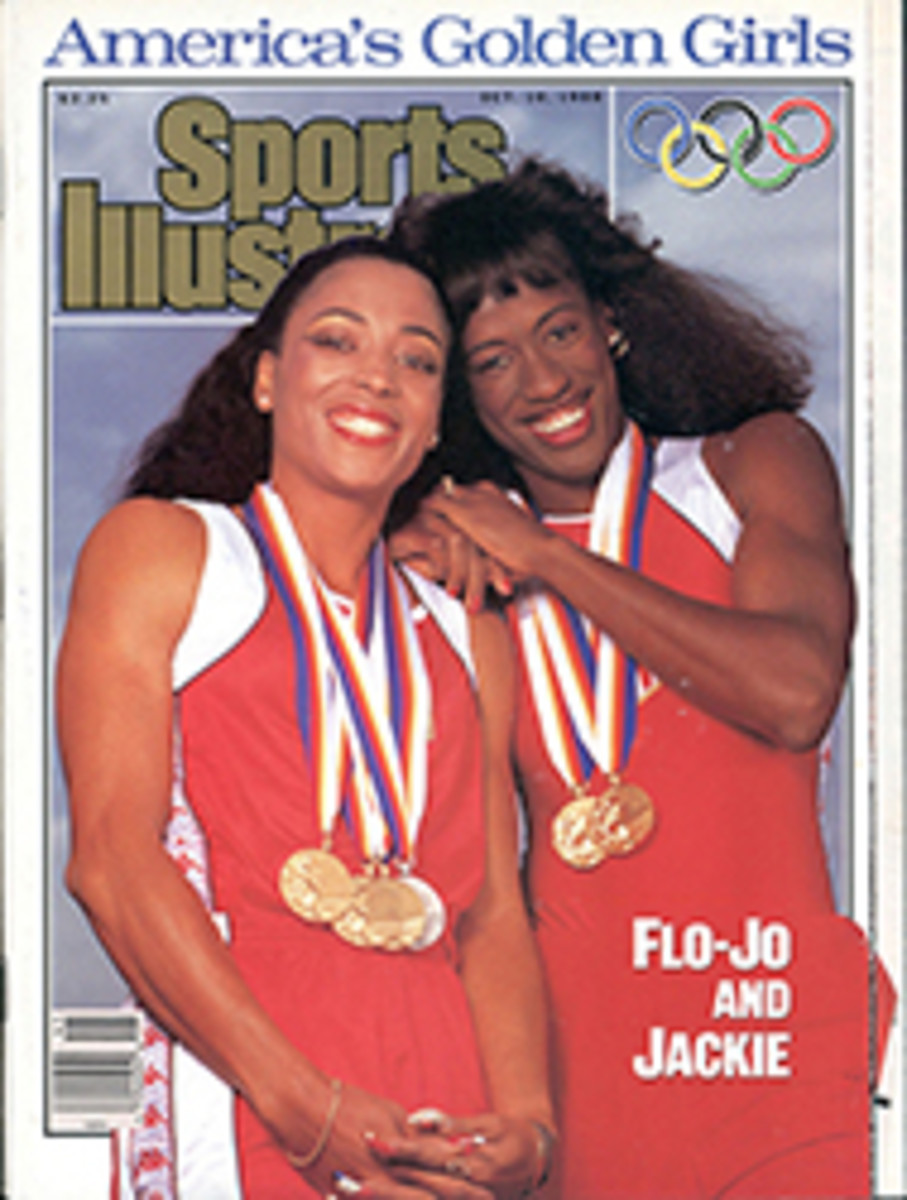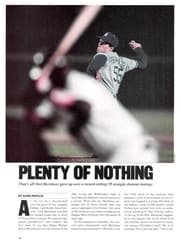
THE DREAMERS WHO PAY FOR PLAY-BY-PLAY
The announcer watches Carney Lansford of the Oakland A's at the plate: "3-2 pitch.... Whoa! Almost hit Lansford!"
"It did hit him!"" says the color commentator.
Apparently not hearing his partner, the play-by-play man asks. "Didn't that hit him?"
"Here's Jon Pino, the A's trainer, coming out to take a look." says the color man.
Well, Lansford was hit, the A's trainer is Barry Weinberg and. hey, who are these clowns anyway?
No, they aren't Vin and Joe on a bad day. They are Mark Pogue, a 27-year-old who owns a vending-machine business, and his friend Kevin Creighton. 25. a computer consultant, both from Fresno, Calif., and they've been having a day of fantasy fulfillment, calling the action in a live major league baseball game. The mysterious Jon Pino, it turns out, is one of Pogue and Creighton's buddies from home.
The two broadcaster wannabes have just experienced Fantasy Play-by-Play. the latest sideline attraction at Oakland Coliseum, in which fans try their hand at broadcasting a live game. Actually, says Pogue, he has been doing fantasy play-by-plays since he and Creighton were kids.
"When we were six or seven, playing baseball, we'd make up our own play-by-play. Or we'd be goofing off in the swimming pool, throwing a ball around: "And he makes a leaping dive!' " Pogue laughs self-consciously. "You know."
Of course we do. Pogue and Creighton, after all. are not alone. We know who we are. And because Andy Dolich. the A's vice-president of business operations, also knows, he came up with the notion of Fantasy Play-by-Play.
"Subconsciously, we all broadcast a game." he says. "And everyone believes they're a better sportscaster than the people they've been watching or listening to." On that premise. Dolich decided to consult with Fred Greene, a 33-year-old radio producer who had worked on the A's radio broadcasts for station KSFO from 1980 to 1986. Greene was also the producer of the nationally syndicated feature Radio Baseball Cards, a series of 60-second interviews with players that ran in '86 and '87. Together Greene and Dolich developed the concept of letting fans call the action during an actual A's game.
Now, equipped with microphones, binoculars, charts showing players' positions and the same set of updated stats provided to the daily media, fans get to call the action for a half inning, regardless of its length, from a mock broadcast booth overlooking the field. Behind them, an engineer records their work on tape—$20 for an audio, $30 for a video that mixes local or network pictures with shots of the two broadcasters hard at play. The arrangement with the A's is simple: In exchange for a share of the proceeds the A's donate the space, provide a mention of the program and a quick shot of the Fantasy announcers on the Diamond Vision screen, and give Greene A's tickets and media statistics to be included in the package for the participants.
The scheme, hatched before the '87 season but not launched until after the All-Star Game, caught on immediately. Entire games—especially against such teams as the Yankees, Red Sox, and Twins—are frequently sold out in advance. During the off-season, Greene decided to spread the word, selling the concept to Pittsburgh and eliciting interest from Cleveland, Seattle and the Chicago White Sox. Perhaps the surest sign of success is that Fantasy Play-by-Play has spawned at least one imitator: a version called Fantasy Baseball in San Diego.
But Greene's own fantasy of placing his idea in every major league ballpark has yet to be fulfilled. The stumbling block, of course, is money. To get Fantasy started, he needed sponsors to help underwrite the costs. Most companies, Greene says, didn't understand the value of his scheme to put a commercial message on each tape: "It was like, 'One person's going to hear the tape.' I said, 'You have one impression, but it's a lasting one. It has played over and over again.' "
Last season Greene made do with advertisers from the Oakland area. This year he solicited national support. After 30 presentations, he hit a homer: Anheuser-Busch and its Bud Light beer signed on.
In exchange for financing Fantasy this season, Bud Light gets a 10-second spot inserted in each fan's tape, a neon sign in the broadcasting booth, signs around the park and a commercial in every real radio broadcast of A's games. Bud Light also sponsored a season-long contest in which entrants submitted letters to KSFO explaining why they should be given a broadcasting opportunity. The winner was awarded a free visit to the Fantasy booth. According to Joe Castellano, Anheuser-Busch's director of sports marketing, the company may help market the Fantasy concept to other teams. "It's in the category of, 'Let's give it a run and see what kind of reaction we get,' " he says.
If Pogue's reaction is any indication, the program is a hit. "It was fantastic," he said several days after his taping. "We sped home to put on the video. We've played it for anyone who comes and visits." He has even forced several of his customers to listen to his tape. "Two of them thought we'd actually been broadcasting."
Last season Fantasy drew a variety of couples: husbands and wives, boyfriends and girlfriends, fathers and sons. One bit of dialogue went like this:
Thad: "Looks like we've got a pitching change."
Mary Jo: "Thank goodness! I'm ready for some new action, aren't you?"
Thad: "Oh, I've been pretty content as of late, Mary Jo."
Then, of course, there are the serious fantasizers. Dennis Lyons, 32, is a bartender in Hayward, Calif. In his quest to become a baseball play-by-play announcer, he has attended the Columbia School of Broadcasting, San Francisco branch. He has studied with Chick Hearn, voice of the Lakers, and Al Conin, a broadcaster for the California Angels, at the Sportscaster Camps of America in Los Angeles. And he has been to Fantasy Play-by-Play half a dozen times to make demonstration tapes to send off to various potential employers.
"It's great," Lyons says. "Doing a game off the TV, you never get the full range of where the ball's going, how far it's going. By the time the ball leaves the bat and they switch to where the ball's going, there's a loss there. At the park, you hear the surroundings. It's the best thing for me."
At the park today the A's are hosting the Minnesota Twins, and in the Fantasy box, Don Loessberg, 22, and Scott Alexander, 35, both of Santa Rosa, Calif., are waiting for their half inning. In their seats they warm up by calling the action. "The rock, the deal, strike'." shouts Loessberg, while Alexander supplies the color.
Loessberg, an avid A's fan and a student disc jockey at Sonoma State in Rohnert Park, Calif., is on a mission here. "Play-by-play is what I really, really love," he says. "Even when I play, I'm announcing to myself."
In the booth Loessberg is smooth: "There's a ball hit to Gagne, the throw to first—Henderson's motoring—he's out, two down." Alexander forgets his color role, butting in on Loessberg's play-by-play. And Loessberg is so intent on the game that he ignores some of Alexander's comments.
No matter. At inning's end, the guys are delirious. "Thank you, Bud Light!" shouts Loessberg. "Hi, Mom," says Alexander.
When Loessberg plays back his tape, he'll hear a mix of slick and slop. He won't be surprised.
"It's easy to sit home in front of the TV with a beer and announce the game," says Loessberg. "But here there's a lot of stuff going on. You have to interact with another announcer. And you can't call the play too quickly or be too harsh on a player. You have to understand that it's a tough job to hit a baseball."
"What they find out," says Steve Greenberg, the Pirates' vice-president of sales and marketing, "is that broadcasting is not as easy as it seems. Those half innings take a long time; there's a lot of dead airtime, and it's not as easy to fill as people think it is. You see people in the Fantasy booth up there staring at each other."
In the seats near the A's Fantasy booth, Don Willis sits with his family. Willis, 38, is the athletic director of the Log Cabin Ranch, a residence for delinquent adolescent boys in La Honda, Calif. He has just completed his broadcasting stint, and now he's playing his half inning back on a portable cassette machine, chortling over his bons mots. "I'm gonna cherish this!" he says.
The playback reveals Willis to be a dynamo of enthusiasm with a decided propensity for overload. In excruciating detail, he describes every movement of the pitcher, the batter, the fielders and the umpires. He has fun with the baseball cliches—"Here's the wheel; here's the deal"—but when the deal comes down and the ball is put in play, he stumbles over words that he can't get out fast enough. From his perch above the first base foul line, he has trouble judging direction and distance on fly balls.
Here's the difference between a heated fan and a cool pro. Minnesota outfielder Kirby Puckett is batting. Fantasycaster Willis calls it this way:
"Here's the pitch to the plate. Swung on, tapped—what is it? Tapped... foul. Now wait a second, let's see what's happening. Home plate umpire's coming out, third base umpire's holding up his hands. That's what it was, ladies and gentlemen, a foul ball off the plate."
A's broadcaster Bill King described it like this:
"Chopped foul off the foot of Puckett in the batter's box, and the count is 1 and 1."
I'm not much better when I take the mike. I can't follow the paths of fly balls, lose track of the count and call a dropped third strike a foul tip. Fortunately, I have my friend Adam Rubin-son, a young man who actually knows something about baseball, at my side. Still, when Adam calls a hit an error, I'm there to correct him. By the end of our half inning we're just getting warmed up, and we wind up calling most of the rest of the game into my tape recorder.
We should feel foolish. We should be self-conscious. But we don't, and we aren't. After all, we know we are not alone.
PHOTO
MICHAEL ZAGARIS
Loessberg (left) and Alexander call the action, and Greene grins at the results.
PHOTO
V.J. LOVERO
Dolich knew that closet commentators could be lured to his booth to air their fantasies.
San Francisco writer Ben Fong-Torres is a former senior editor at "Rolling Stone."

